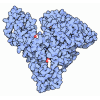Entry Database : PDB / ID : 3oapTitle Crystal structure of human Retinoid X Receptor alpha-ligand binding domain complex with 9-cis retinoic acid and the coactivator peptide GRIP-1 Nuclear receptor coactivator 2 Retinoic acid receptor RXR-alpha Keywords / / / / / Function / homology Function Domain/homology Component
/ / / / / / / / / / / / / / / / / / / / / / / / / / / / / / / / / / / / / / / / / / / / / / / / / / / / / / / / / / / / / / / / / / / / / / / / / / / / / / / / / / / / / / / / / / / / / / / / / / / / / / / / / / / / / / / / / / / / / / / / / / / / / / / / / / / / / / / / / / / / / / / / / / / / / / / / / / / / / / / / / Biological species Homo sapiens (human)homo sapiens (human)Method / / / Resolution : 2.05 Å Authors Xia, G. / Smith, C.D. / Muccio, D.D. Journal : Biochemistry / Year : 2011Title : Structure, Energetics and Dynamics of Binding Coactivator Peptide to Human Retinoid X Receptor Alpha Ligand Binding Domain Complex with 9-cis-Retinoic Acid.Authors : Xia, G. / Boerma, L.J. / Cox, B.D. / Qiu, C. / Kang, S. / Smith, C.D. / Renfrow, M.B. / Muccio, D.D. History Deposition Aug 5, 2010 Deposition site / Processing site Revision 1.0 Nov 17, 2010 Provider / Type Revision 1.1 Jul 13, 2011 Group Revision 1.2 Jun 19, 2013 Group Revision 1.3 Nov 16, 2016 Group Revision 1.4 Nov 8, 2017 Group / Category Revision 1.5 Aug 17, 2022 Group / Derived calculationsCategory database_2 / pdbx_struct_assembly ... database_2 / pdbx_struct_assembly / pdbx_struct_assembly_gen / pdbx_struct_assembly_prop / pdbx_struct_oper_list / struct_site Item _database_2.pdbx_DOI / _database_2.pdbx_database_accession ... _database_2.pdbx_DOI / _database_2.pdbx_database_accession / _pdbx_struct_assembly.details / _pdbx_struct_assembly.method_details / _pdbx_struct_assembly.oligomeric_count / _pdbx_struct_assembly.oligomeric_details / _pdbx_struct_assembly_gen.oper_expression / _struct_site.pdbx_auth_asym_id / _struct_site.pdbx_auth_comp_id / _struct_site.pdbx_auth_seq_id Revision 1.6 Feb 21, 2024 Group / Category / chem_comp_bond
Show all Show less
 Yorodumi
Yorodumi Open data
Open data Basic information
Basic information Components
Components Keywords
Keywords Function and homology information
Function and homology information Homo sapiens (human)
Homo sapiens (human) homo sapiens (human)
homo sapiens (human) X-RAY DIFFRACTION /
X-RAY DIFFRACTION /  SYNCHROTRON /
SYNCHROTRON /  MOLECULAR REPLACEMENT / Resolution: 2.05 Å
MOLECULAR REPLACEMENT / Resolution: 2.05 Å  Authors
Authors Citation
Citation Journal: Biochemistry / Year: 2011
Journal: Biochemistry / Year: 2011 Structure visualization
Structure visualization Molmil
Molmil Jmol/JSmol
Jmol/JSmol Downloads & links
Downloads & links Download
Download 3oap.cif.gz
3oap.cif.gz PDBx/mmCIF format
PDBx/mmCIF format pdb3oap.ent.gz
pdb3oap.ent.gz PDB format
PDB format 3oap.json.gz
3oap.json.gz PDBx/mmJSON format
PDBx/mmJSON format Other downloads
Other downloads 3oap_validation.pdf.gz
3oap_validation.pdf.gz wwPDB validaton report
wwPDB validaton report 3oap_full_validation.pdf.gz
3oap_full_validation.pdf.gz 3oap_validation.xml.gz
3oap_validation.xml.gz 3oap_validation.cif.gz
3oap_validation.cif.gz https://data.pdbj.org/pub/pdb/validation_reports/oa/3oap
https://data.pdbj.org/pub/pdb/validation_reports/oa/3oap ftp://data.pdbj.org/pub/pdb/validation_reports/oa/3oap
ftp://data.pdbj.org/pub/pdb/validation_reports/oa/3oap F&H Search
F&H Search Links
Links Assembly
Assembly

 Components
Components Homo sapiens (human) / Gene: RXRA, NR2B1 / Production host:
Homo sapiens (human) / Gene: RXRA, NR2B1 / Production host: 
 homo sapiens (human) / References: UniProt: Q15596
homo sapiens (human) / References: UniProt: Q15596 X-RAY DIFFRACTION / Number of used crystals: 1
X-RAY DIFFRACTION / Number of used crystals: 1  Sample preparation
Sample preparation SYNCHROTRON / Site:
SYNCHROTRON / Site:  APS
APS  / Beamline: 22-ID / Wavelength: 1.5418 Å
/ Beamline: 22-ID / Wavelength: 1.5418 Å Processing
Processing MOLECULAR REPLACEMENT / Resolution: 2.05→50 Å / Occupancy max: 1 / Occupancy min: 1 / FOM work R set: 0.8623 / σ(F): 0
MOLECULAR REPLACEMENT / Resolution: 2.05→50 Å / Occupancy max: 1 / Occupancy min: 1 / FOM work R set: 0.8623 / σ(F): 0  Movie
Movie Controller
Controller



 PDBj
PDBj













